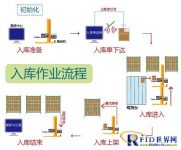
RFID Stereoscopic Warehouse Management System
[ad_1]
In the current process of social and economic development, more and more automated, information-based three-dimensional warehouses are increasingly appearing in people’s sight. Because the barcode technology has its own shortcomings, it will definitely not be suitable for the development of the logistics industry in the future. Tianjin Bee believes,RFIDThe emergence of technology has solved the problem of automatic data identification, processing information more quickly and accurately, reducing manual intervention, avoiding cumbersome manual input and other processes, thereby reducing costs.
RFID has the following advantages: fast processing speed; small size and diversified shapes; strong anti-pollution ability and durable; reusable; strong penetrability, which can realize barrier-free reading; large data memory capacity; high security. The RFID three-dimensional warehouse management system combined with the three-dimensional warehouse will surely become the future three-dimensional warehouse management model.
RFID technology mainly reflects the function of automatically detecting and updating data information in the management process of the entire three-dimensional warehouse. For example, it is mainly divided into two functions in the application, namely, read information operation and write information operation. For the read and write operations of electronic tags, there is a corresponding fixed communication format in the corresponding system, and the user can complete the corresponding control only according to the communication format.
RFID hardware facilities:
1Electronic label
Composed of coupling components and chips, eachelectronic labelWith a global identification number (ID), it cannot be modified or counterfeited, providing security. Electronic tags must be attached to objects to mark the target object. The electronic label generally saves electronic data in an agreed format, such as the type, production batch, quantity, and location number of the shelf where the object to be identified is stored.
2 antenna
The radio frequency signal is transmitted between the tag and the reader, that is, the data information of the tag and the command information issued by the reader.
3 reader
Devices that read or write electronic tag information, including handheld and fixed types. The reader can read and identify the electronic data stored in the electronic tag without contact, so as to achieve the purpose of automatically identifying the object. And it is connected with the computer to process the read label information.
RFID three-dimensional warehouse management system process:
Warehousing operation process
1 Preparation for storage.
The storage preparation of the system includes initialization of the system state and data initialization. At this time, the stacker is in the initial state, and the ID controller is ready to detect the goods.
2 Release of warehousing order
The warehousing order can be sent to the main controller manually or electronically. The main controller recognizes the type of goods according to the information on the warehousing order, and at the same time processes the ID information of the detected goods fed back by the RFID reader. The two information is compared. When the goods information is consistent with the warehousing list, the system automatically assigns a location number to the warehousing goods, which is written into the RFID electronic tag by the reader.
3 Warehousing access
Inbound entry means that the stacker is transferred from the inbound port to the pickup platform.The system assigns a space coordinate point to the stacker according to the warehouse number assigned by the goods. At this time, the stacker runs from the initial state to the warehouse entrance, and transfers the goods from the loading platform to the stacker’s pickup platform. Prepare for the next release
4 Put into storage and put on shelves. Inbound and shelf-in is the last operation step of warehouse inbound. The stacker will put the goods on the pick-up table into the designated storage location. The stacker automatically finds an optimal trajectory according to the space coordinate points allocated by the system, and delivers the goods from the warehouse entrance to the warehouse.
5 End of warehousing
After the goods are put on the shelves, the stacker returns to the standby state, and the system updates the location data and completes the corresponding records.

Outbound workflow
1. Preparation for delivery
The preparation of the system is similar to the preparation of the warehouse.
2. Release the outbound order
The outbound order can be sent to the main controller manually or electronically. The main controller can identify the type of goods based on the outbound order information. At the same time, it also needs to process the ID information of the detected goods fed back by the RFID reader , Compare the two information, when the goods information is consistent with the outbound order, the system is ready for outbound.
3. Out of the warehouse and enter
After the system confirms the outbound operation, the stacker will obtain a certain spatial coordinate point according to the location information determined by the outbound order. Under the operation of the main controller, the stacker will follow the optimal path from the current position to the designated position.
4. Out of the warehouse and off the shelf
In the warehouse area, the stacker removes the goods from the designated position, and at the same time the read-write head reads the goods ID information and feeds it back to the main controller. The main controller judges whether the outgoing goods information is consistent with the outgoing order information. When the information is confirmed, it executes the pickup operation and transports the goods to the outbound port. At the same time, the electronic label system writes out the outgoing information into the electronic label. Update storage data.
5 End of delivery
The stacker returns to the standby state, the system data is updated, and the corresponding records are completed.

Tianjin Little Bee has been engaged in RFID technology research and development and solution development services for a long time. In the long-term practice process, RFID technology embodies the characteristics of high efficiency and speed, speeds up the boring turnover, improves the overall warehouse operation efficiency, and improves The accuracy and safety of warehouse management.
[ad_2]



